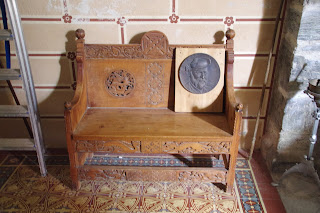 |
| A Look at Vik from Above |
Vik, a small city on the shores of an arm of Norway’s largest fjord, the Sognefjord, is the home of two magnificent medieval churches. We were interested in them because our friend Cherie’s family has roots in the area and she had found a photograph of the Hove Stone Church in some papers of her sister’s. When we realized we were staying only a short drive from Vik, we decided to give them a visit.
Our first stop in Vik was at the Hopperstad Stave Church. Approximately 1000 stave churches were built in Norway during the Middle Ages. None were built after the Reformation because of their ‘Catholic-ness’ and they fell into disrepair. Only 28 remain today, mostly in rural Norway.
 |
| An outside decoration |
Built around 1130, the Hopperstad church was restored in the late 1800s by Peter Blix, one of Norway’s leading architects. The story really begins with the other medieval church in Vik, the Hove Stone Church. At the time Blix was working on King Hakon’s Hall in Bergen. He was offered some trimmed soapstone for that job. Because soapstone in trimmed condition is rare, he assumed it came from an old church ready to be torn down. Upon investigation, he learned that the stone would come from the Hove Stone Church in Vik. Instead of taking the offer of the soapstone, he tried to get the city to save the old church. When that effort failed, he purchased it himself and paid for the restoration work between 1883 and 1886.



While planning the work on the Hove Stone church, he learned that the nearby Hopperstad Stave Church was in even worse condition. When he couldn’t get the city fathers interested in saving that church either, he offered to oversee the work free of charge and managed to raise much of the money for the restoration on his own. Thus, he was able to save both medieval churches in the town. Using pictures of the original church and his knowledge of other stave churches, he did his best to restore both to their original Catholic origins.
 |
| The altar is on the left. the posts leading to the chancel have been polished by being touched for eight centuries |
 |
| Note the decorations above the altar. |
 |
| They depict the birth and childhood of Jesus |
|
|
|
|
|
|
|
|
|
The church has an interesting origin. The story is that it was to be built further from town at a higher elevation, but the morning construction was to begin, the town awoke to discover that all the building materials had been moved. Assuming this was divine intervention, they decided to built the church on this new site.
 |
| One of the priests carved his initials here. |
 |
| This intricate wood carving is in the entry way. |
The ancient graffiti has been painted white so we can see it more easily. Pictures include dangerous animals with sharp teeth, fish, and boats, along with some personal marks and symbols. At least twenty different pictures have been found.
As a side note, as we approached the stave church, we realized that we had been there before. On our 2011 fjords tour, we stopped at this church for a few minutes to take pictures of the outside. We had to catch a ferry, so we weren’t able to see the inside at that time, so this was still a new experience for us.
Our admission price included a tour. In addition to pointing out the different aspects of the church our guide had a flashlight that he used to illuminate the highlights in the dark interior.




















































